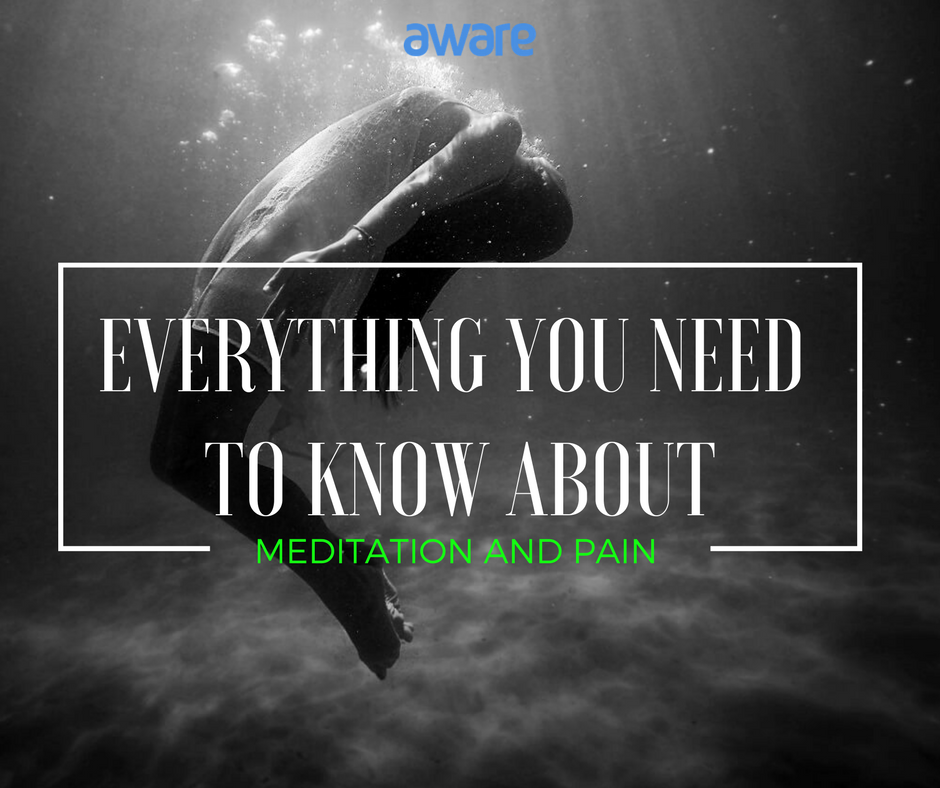
18 Apr How Meditation Can Drastically Reduce Pain- Backed by Science!
An article in The Journal of Pain estimated persistent pain to cost from $560 to $635 billion annually, which exceeds the price of other costly diagnoses, by miles, such as cardiovascular disease, injury, and cancer! These costs arise from medical expenditures for the pain, as well as for other conditions complicated by pain, and a hindering of the patient’s ability to work or function.
I have recently pulled my groin tendon, and that cost me around a $100 for physiotherapy treatment, at home treatment (strap on ice pack, foam roller, tapes, etc), and luckily, it isn’t persistent pain( I could only imagine the cost if it nagged me day and night.) Not only is pain expensive to recover from, it is also difficult to manage.
Lately, I’ve been affected mentally, to some extent too. I miss the ability to move around freely, and it’s not just the pain, it’s also how my mind can find a way to ask bitter questions nagging at my soul like” When can I recover from this?” “Will I recover completely or will it persist” “What if it gets worse”…
So I wanted to understand the reason behind this, by first learning why we experience pain:
What is Pain?
According to Dr John Loeser, who is a neurological surgeon and a pain expert at the University of Washing, he describes pain as a very complex phenomenon that involves biological things, psychological things, and sociological or environmental things.”
What is Acute and Chronic Pain?
Acute pain is primarily biological. The body contains many types of nerves: afferent nerves, which conduct information from the senses to the central nervous system; efferent nerves, which conduct movement information from the central nervous system to the muscles; spinal nerves; and cranial nerves. Since pain is part of the sensory perception, it travels along the afferent nerves from the body to the brain. The specific nerves for pain and temperature conduct information slowly. Thus, when a person touches a burning stone, it takes a fraction of a second to move his or her finger, and a fraction of a second more for it to hurt.
This explanation describes pain at its most basic, tangible, straightforward level. Pain is when something injures body tissue, and the body tells this to the brain.
“Tissue damage, normally leads to pain, but pain always has a sensory component: where it is, what it feels like. It makes you feel bad,” Loeser said. What physicians respond to, he explained, is the behaviors of a patient. A person comes into the clinic and expresses and shows how bad he suffers from the pain he feels. The doctor cannot see or measure the pain and suffering. This scenario explains Loeser’s model of pain, which he conceived and wrote about in 1982.
The complexity of pain lies in the fact that physical stimuli do not reliably lead to specific responses, Loeser said in his article “What Is Chronic Pain?
“Chronic pain is not the same as the pain you feel from an injury. That’s acute pain—the sensing of tissue damage by nerves. Your body gets injured and you hurt. Chronic pain often, though not always, begins with an injury or tissue damage, but is perpetuated, usually by other factors, long after a reasonable time has passed for the injury to heal. Data have shown that an accurate diagnosis can only be established in approximately one-third of patients with low back pain. The relentless nature of chronic pain suggests that stress, environmental, and emotional effects likely overlay the original tissue damage in an injury, adding to the intensity and tenacity of the pain.
Meditation and Pain - Does it really make a difference?
The meditative approach is to reduce our natural struggle against suffering.
It is very normal for us to want to find relief from pain, but what if the rush to recovery can make it worse?
Meditation helps to manage pain by exploring the sensations of pain as they come and go in your body (also known as body scanning). I know it’s crazy to ask someone who is in pain to go deep and feel the body, but the latest medical research shows that meditation is more powerful than most often prescribed painkillers.
Mindfulness meditation has been shown in clinical trials to reduce chronic pain by 57 percent. Accomplished meditators can reduce it by over 90 percent. Imaging studies show that mindfulness soothes the brain patterns underlying pain and, over time, these changes take root and alter the structure of the brain itself, so that patients no longer feel pain with the same intensity. Many say that they barely notice it at all.
Many hospital clinics now rely on mindfulness meditation to help patients to cope with the pain and suffering of diseases such as cancer (and the side effects of chemotherapy), heart disease, diabetes and arthritis. It is also used for back problems, migraine, fibromyalgia, coeliac disease, chronic fatigue, irritable bowel syndrome and even multiple sclerosis.
What Happens When We Meditate For Pain:
Meditation achieves remarkable results because it turns down the ‘volume’ control on pain according to Danny Penman.
He says that with body scanning, we are able to focus on different parts of the body and simply observe it, using the mind. This way we can connect the mind and the body and observe painful sensations as they come and go, and train the mind to let go of struggling with pain. As you continue to do this, the built up tension in your body will melt away on its own accord.
According to Danny Penman, many don’t have the realization that pain comes in two forms: Primary and Secondary. Each of these has very different causes - and understanding this gives you far greater control over your suffering.
He says that Primary pain arises from illness, injury or damage to the body or nervous system. You could see it as the raw information sent by the body to the brain. Secondary pain is the mind’s reaction to Primary pain but is often far more intense and long-lasting. Crucially, it is controlled by an ‘amplifier’ in the brain that governs the overall intensity of suffering.
In recent years, scientists have begun to work out how the mind’s pain amplifier is controlled, but more importantly, they have discovered ways of turning down the ‘volume’ control on suffering. - which is what Dr Sonty did. (see below)
It turns out, the human mind does not simply feel pain, it also processes the information that it contains, says Penman. It teases apart all of the different sensations to try to find their underlying causes so that you can avoid further pain or damage to the body. In effect, the mind zooms in on your pain for a closer look as it tries to find a solution to your suffering. This ‘zooming-in’ amplifies pain.
He says that as your mind analyses the pain, it also sifts through memories for occasions when you have suffered similarly in the past. It is searching for a pattern, some clues, that will lead to a solution.
Trouble is, if you have suffered from pain or illness for months or years, then the mind will have a rich tapestry of painful memories on which to draw - but very few solutions. So before you know it, your mind can become flooded with unsettling memories. You can become enmeshed in thoughts about your suffering. It can seem as if you’ve always been ill and in pain, that you’ve never found a solution and that you never will. You can end up being consumed by future anxieties, stresses and worries as well as physical pain: What will happen if I can’t stop this pain? Am I going to spend my life suffering like this? Is it going to keep on getting worse?
Penman says this process happens in an instant, before you’re consciously aware of it. Each thought builds on the last and quickly turns into a vicious cycle that ends up further amplifying your pain. And it can be worse than this because such stresses and fears feed back into the body to create even more tension and stress. This can aggravate illnesses and injuries, leading to even more pain. It also dampens down the immune system, so impairing healing. So you can all too easily become trapped in a vicious downward spiral that leads to ever greater suffering.
But even worse, such negative spirals can begin wearing tracks in the mind so that you become primed to suffer. Your brain begins fine-tuning itself to sense pain more quickly - and with greater intensity - in a futile bid to try to avoid the worst of it. Over time, the brain actually becomes better at sensing pain. Brain scans confirm that people who suffer from chronic pain have more brain tissue dedicated to feeling the conscious sensations of pain. It’s almost as if the brain has turned up the volume to maximum and doesn’t know how to turn it down again.
He emphasize that Secondary pain is real. You do genuinely feel it. It’s only called Secondary pain because it is the mind’s reaction to Primary pain and has been heavily processed before you consciously feel it. But this same processing also offers a way out; it means you can learn to gain control over pain.
It is possible to learn to step aside from suffering and begin to handle pain very differently indeed. In effect, mindfulness hands back to you the volume control for your pain.
Brain scans confirm this. Mindfulness soothes the circuits that amplify Secondary pain and you can see this process happening in a brain scanner. In effect, mindfulness teaches you how to turn down the volume control on your pain. And as you do so, any anxiety, stress and depression that you may be feeling, begins to melt away too. Your body can then relax and begin to heal.
Penman also mentions that on top of these benefits, hundreds of scientific trials have now shown that mindfulness meditation is extremely good at relieving anxiety, stress, depression, exhaustion and irritability( all the things that package pain). Memory improves, reaction times become faster and mental and physical stamina increase. In short, regular meditators are happier and more contented than average, while being far less likely to suffer from psychological distress.
The Science Behind This:
For Dr. Nomita Sonty, a psychologist who works with pain patients at Columbia University, Loeser’s model demonstrates the individuality of pain( that means that it’s different for different people because of who they are) .
“Who I am then starts to affect the perception of pain,” she explained. “As soon as I perceive it, I then appraise it.” The patient will then act on his or her appraisal appropriately. Who we are determines how we react when we have pain. Sonty does not use meditation specifically in her practice; instead, she uses visualization and relaxation as a means to give patients control over their pain.
In her most dramatic example of her technique’s success, a paraplegic patient came to visit her at the National Rehabilitation Hospital in Washington, DC. After being paralyzed by an accidental spinal cord injury during surgery, he suffered horrible pain in his lower back so bad he had to lay down in the car as his wife drove him to his appointment. When he arrived, Sonty put him on a bed in the room, and placed electrodes on his back to measure the electrical activity in his muscles.The higher the readings, the more activity in the muscles, meaning the more strained they were. Relaxed muscles have a baseline reading of 2 to 3 mV, she said.
Sonty told her patient to visualize an image of his pain. The man pictured his surgeon holding a knife and stabbing it into his back over and over. The electrodes displayed more than 150mV. She then told him to picture a way for that knife to be removed. He envisioned an ethereal hand—perhaps that of an angel—pulling the hand with the knife back, slowly pulling the knife out of the skin. As he pictured that, the EMG readings continued to drop. When the knife was completely out of his back, the levels on the screen were below 10mV. On the ride home, the patient was able to sit up without any pain. It was an extreme case for Sonty, but she says it showed her the power our brain can have over our body, and our pain.
The mind’s mental processes can alter sensory phenomena, including pain. This is how war wounds can go unnoticed until after battle, athletes can continue to play with debilitating injuries, or minor traumas can lead to incapacitating pain. As knowledge of the nervous system has expanded and technology allowing scientists to visualize the nervous system has advanced, the last 5 to 10 years have seen a dramatic increase in the amount of studies focusing on how meditation works.
In hundreds of studies conducted over the past decade, researchers have examined meditation’s effects on people, such as attention regulation, awareness of the body, depression, post-traumatic stress disorder, and addiction. Scientists have also studied the use of meditation as a treatment for pain.
In these studies, meditation has been shown to help pain, sometimes significantly, though not cure it.
In research on meditation and pain, scientists have asked two questions: “Does meditation help?” and “How does meditation help?” The first question proved much simpler to answer.
A Wake Forest University study conducted by Fadel Zeidan in April 2011 took 15 healthy volunteers and performed MRI scans of their brains while inducing pain.In the four days that followed, a certified instructor taught the subjects mindfulness meditation (in which the pupil is taught to focus on a sense, often his or her breath, while accepting transient thoughts). On the fifth day, the researchers scanned the volunteers again, once while not meditating, and another time while meditating, with pain induced during both sessions.The study showed an approximately 40 percent reduction in pain intensity ratings during meditation when compared with non-meditation.
The study discovered that by activating and reinforcing some areas of the brain used in pain processing, meditation has the overall effect of helping to reduce pain intensity in patients. Other theories on how meditation helps pain exist, including that it decreases stress, which in turn decreases pain. Zeidan explained that meditation has known to be helpful for a while, but he has shown through this study and another conducted in 2010 that it takes much less time to see results than previously thought.
“It worked for beginners,” he said excitedly. It seems a patient does not need to be a zen master of 10 years to reap the rewards of the practice. “Meditation teaches patients how to react to the pain. People are less inclined to have the ‘Ouch’ reaction, and are able to control their emotional reaction to pain.”
Meditation has long been thought to be a means to harness this power. Between the 1930s and 1950s, accounts spilled across the pages of scientific journals relating the almost superhero powers of meditating monks. Reports surfaced of yogis in India voluntarily stopping their heartbeat, or enduring over lengthy periods of time in airtight pits or in extreme cold with no food.
In 1935, Thérèse Brosse, a French cardiologist investigating the field of meditation, reported that one of her subjects was able to stop his heart. As monitoring equipment improved, researchers could not find any meditator to replicate Brosse’s observation; however, they did find meditators who could slow their heart rate or respiration rate.
In 1972, Robert Keith Wallace and Herbert Benson published a groundbreaking study about the science behind meditation. The study, an investigation following 36 subjects ranging in meditation experience from one month to nine years, found that meditating reduced activity in the sympathetic nervous system, otherwise known as the fight or flight response. This response increases blood pressure and heart rate, constricts blood vessels, and increases metabolism.
Many forms of stress, including such things as a busy schedule or exhaustion, induce these conditions.
Sonty said she believes meditating reduces pain by reducing stress. When a person is upset and agitated, she explained, their nervous system is aroused. This arousal aggravates pain, which in turn becomes another stressor. By relaxing the sympathetic nerves, stress decreases, thereby decreasing pain.However, studies conducted within the past 10 years have shown that meditation may be able to change the brain. Four areas of the brain involved in pain processing or emotional and behavioral regulation have been shown by Zeidan to have differing activity levels during and after meditation. Seven other separate researchers have shown these same areas to be affected by meditation in other studies as well.
The primary somatosensory cortex, anterior insula, anterior cingulate cortex, and prefrontal cortex all experienced altered levels of activation due to meditation. The primary somatosensory cortex is the area of the brain directly involved in pain processing. If a person cuts himself with a knife, this area of the brain figures out where the pain is and an initial pain level. The anterior insula, the brain region involved in perceiving and regulating the body (it participates in monitoring a person’s heart rate and blood pressure for example), appraises pain in the body. After the person’s hand has been cut by the knife, the insula judges how painful the resulting wound is.
The anterior cingulate cortex regulates a person’s emotional response to various stimuli. The person who cut his hand then feels angry, scared, or frustrated by the wound. Finally, the prefrontal cortex, the command center of the brain, takes information and guides thoughts and actions, including the inhibition of inappropriate thoughts, distractions, and feelings. After beginning to feel angry, the man with the cut on his hand acts out because of the wound.
Meditation has been shown to alter these four areas of the brain. By decreasing activity in the primary somatosensory cortex, the pain processing area, and increasing activity in the three other regions, pain is reduced.
Consider from the previous example that the man who cut his hand meditates. Zeidan’s study showed a reduction in activity in the pain processing area of the brain, meaning the cut won’t hurt as much from the beginning. Meditation also increases activity in the pain and emotion regulating areas of the brain.
After the man cuts his hand, he won’t judge the pain to be as strong, and he will regulate his emotional response to the pain as well as his behaviors. Zeidan’s study showed overlap between pain and meditation in all four regions of the brain. Other studies investigating the science of meditation, without its relationship to pain, had previously shown three of these four regions to be involved in meditation.
For a patient with chronic pain, Loeser explained, meditation gives patients a way to take hold of their life again. Over the months, or even years, of undiagnosed pain, patients feel like they lose control of their life and body. Traditional medications no longer work.
“For most people, you can’t treat chronic pain with opiates,” Loeser said, “but primary care is dumping narcotics into people.”
Pain medications ignore the psychological and social aspects of pain. Meditation, however, can treat pain from every level of Loeser’s model of pain, suffering, and behaviors. It diminishes the anxiety surrounding pain, leaving the patient happier, and more in control.
Nehita is a mindfulness expert who writes extensively on lifestyle management, wellness and ways to lead a healthier and a happier life. She is a part of Aware’s expert team on meditation. She is also an avid artist who spends most her time dribbling amazing stories through art.
References have been taken from
http://www.huffingtonpost.co.uk/danny-penman-phd/mindfulness-meditation-reduce-pain_b_4356325.html
https://www.theatlantic.com/health/archive/2014/04/treating-chronic-pain-with-meditation/284182/






No Comments